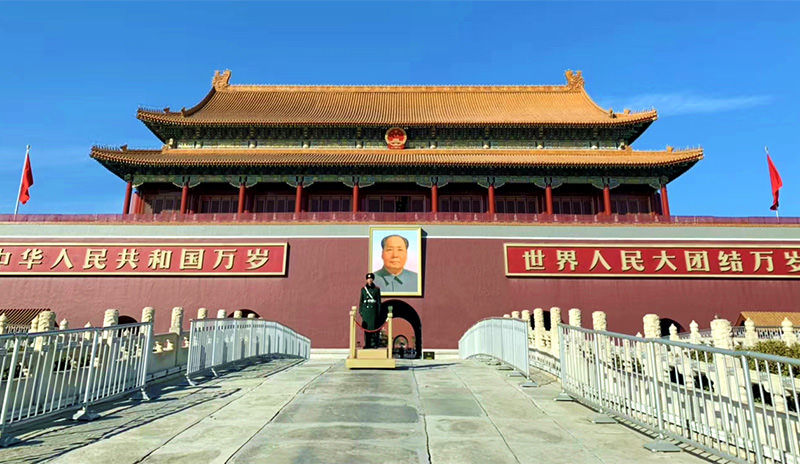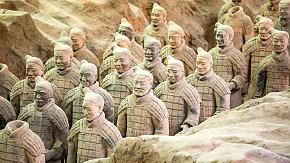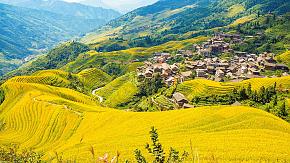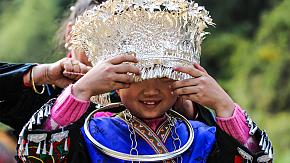China in Five Senses
It is said by scientists that we have five senses. Some people say we have six or even more. I don't know. However many there are, when we travel, we use them all, even if we don't realise it at the time. Here, I want to try to explore and introduce China through my senses, but I will limit them to the five most commonly accepted: sight, taste, smell, touch, and hearing. You'll have to use your sixth sense to learn more!
1. SIGHT
There are so many visual delights in China that it's hard to know where to begin. Obviously, the Great Wall, Beijing's Forbidden City and Tiananmen Square, Xi'an's Terracotta Warriors, Shanghai's Bund architecture, and the karst landscape of Guilin. Seeing those with your own eyes is a whole different experience from seeing them on television or in a travel guide. They are unforgettable, but, there are so many more, and in a richer variety than can be imagined.
 Tiananmen Gate of the Forbidden City
Tiananmen Gate of the Forbidden City
China is vast and stretches from the borders of Siberia in the northern province of Heilongjiang, home to the annual Harbin Ice Festival, down to the tropical island of Hainan with its beautiful beaches. East to west, it stretches from the plains of the Yangtze Delta near Shanghai to the deserts of Xinjiang provinces. In the south-west, we have the karst hills of Guangxi, the eternal spring province of Yunnan, and the high Himalayan mountains of Tibet. So, it should be no surprise that China offers a great variety of visual feasts.
 The beautiful karst landscape in Guilin, Guangxi
The beautiful karst landscape in Guilin, Guangxi
The beaches and German architecture (not to mention Tsingtao beer) of Qingdao in Shandong province; Suzhou, China's beautiful canal and garden city in Jiangsu province, near Shanghai; the incredible landscape of Zhangjiajie in Hunan province; the grasslands of Inner Mongolia; the throbbing, modern powerhouse city of Shenzhen beside Hong Kong; the Stone Forest in Yunnan; the colourful costumes of China's ethnic minority groups. The list goes on and on.
 Yao minority ladies in Longji Rice Terraces
Yao minority ladies in Longji Rice Terraces
Chinese art is also very different from Western art. Highly stylised nature paintings, particularly of flowers, trees, mountains and rivers are beautiful and popular. Chinese calligraphy is considered an art form. Unfortunately, not one I know how to understand or appreciate. The ethnic minority folk art is also beautiful in a different way. Highly coloured naïve art depicting scenes from everyday life is produced by subsistence farmers in the countryside.
 Dong farmer's art
Dong farmer's art
But some of my favourite sights have been simpler than the usual tourist views. They would be the people, the markets, the food, etc. Really, I guess I mean the "normal" daily life of the Chinese people, but that is "normal" in a different way from home "normal". I've lived in China for many years and every day I still see something new, surprising, interesting, beautiful or all four together.
Chinese people love to take photographs and to have them taken, so bring your cameras or cell phones and shoot away. Make sure you have enough memory cards – you will take at least double what you expect.
Of course, it is polite to ask people for permission before snapping – a gesture will do – and most will be delighted although they may want one of you, or with you too! However, be aware that some of China's ethnic minorities are less happy or even have taboos against personal photography. If someone expresses unhappiness or even more at being photographed, please don't intrude.
Also, as in most countries, photographing police on active duty or the military or military establishments is not permitted. This also applies to airport immigration halls, etc. In the unlikely and rare event that you happen to come across any public disturbances, put your camera away and walk on.
But I suggest, sometimes it's just good to put away your camera for a few moments anyway and just look directly. The pictures in your mind will last longer and be more powerful.
2. TASTE
We all think we know Chinese food, but paradoxically, it is both one of the best known cuisines and one of the least known or misunderstood cuisines. There are Chinese restaurants in every town and city in Europe and North America. My mother lives in a tiny village in the UK and it has three Chinese restaurants. If the whole village went out for dinner, they wouldn't fill them.
 Beijing soy paste noodles
Beijing soy paste noodles
Related Post: A Bite of Beijing: 6 Street Snacks with Rich Culture
However, the food I found in China was completely different from anything I ate there. What was going on? It turns out that western "Chinese food" usually isn't actually very Chinese; more "Chinese influenced". Favourite dishes in your local restaurant back home are unknown to most Chinese people. America's favourite, General Tso's Chicken was invented in America and is unknown in Hunan, its purported birthplace. And although sweet and sour pork does exist in China, it is nothing like the day-glo orange concoction served in western Chinese restaurants. The good news is that the real stuff is much better! Traditionally, it is said that China has eight distinct cuisines: Cantonese, Sichuan, Anhui, Shandong, Fujian, Jiangsu, Hunan, and Zhejiang. These are certainly among the top, but there are also many others, particularly, those of Xinjiang, Yunnan, Tibet and Inner Mongolia. This is hardly surprising given China's size and highly varied geography and climates.
 Sichuan hot pot
Sichuan hot pot
In fact, I feel that almost every city and village has a slightly different cuisine and each has at least one local dish all to itself. I live an hour away from Guilin, for example, but the food there is, in several ways, different to the food in my city and each has its own specialties.
Visit the markets and see the astonishing range of fruit and vegetables on offer, especially in the south, and marvel at the things you see which you don't even recognise! But most of all eat! You will always find something edible! If you really don't like Chinese food or want a change, the major international chains are here, too. KFC, McDonalds and Pizza Hut, etc are almost everywhere. Many international style hotels have western restaurants of varying quality and authenticity. In the largest cities such as Beijing and Shanghai, there is almost nothing you can't find. Even more so, in Hong Kong.
 Fruits found in the south of China
Fruits found in the south of China
And of course, drink. What is China's most popular drink? Probably tea. But so many different teas to choose from. First, decide on green tea or black. Then be confused when you are told they only have green and red. Don't worry, red tea is what English calls black tea. Then be utterly baffled when you are offered white tea. Be careful though, tea prices range from next to nothing all the way up to prices matching the best Beluga caviar. Make sure you know what you are ordering. Consult your guide if in doubt.
 Chinese black tea
Chinese black tea
Also, beware of "wine". There is a common translation problem. What is called "wine" in China isn't always what you may call wine. It can be a very strong distilled spirit, and most non-Chinese (and many Chinese) find it very much an acquired taste. China does produce some excellent grape wines and major hotel and up-market restaurants will offer international wines.
3. SMELL
Of course, smell is closely linked to taste and you will smell food almost everywhere, either in cooking or in fresh ingredients in the markets. I think I can almost tell what city or province I am in by smell alone. From the citrus scent of Sichuan peppercorns, to the astonishing, literally breath-taking aroma of cooking chilli peppers in Hunan; from the smoky smell of charcoal grilled lamb skewers in Xi'an to the earthy delight of Yunnan's wild mushrooms; from the 5-spice sensation of Hong Kong to the fragrant fruit of Hainan Island.
 Sichuan peppercorns
Sichuan peppercorns
 Yunnan wild mushrooms
Yunnan wild mushrooms
But there are other smells. From Guilin in the south come sweet osmanthus flowers. In fact, Guilin means "osmanthus forest". In Zhangjiajie in Hunan, the incredible scenery is often shrouded in mist releasing the fresh aroma of wet leaves; in Yunnan we find Kunming, now famous for its flowers.
4. TOUCH
We often don't think of touch as being so powerful a memory trigger. But think. Have you ever lain on a beach and run your fingers through warm sand? You can do that in China, too. Qingdao in Shandong province, eastern China has beautiful beaches as does Beihai in Guangxi near the border with Vietnam. But probably the most treasured beaches are those of Hainan, the island province in the south – especially those in Sanya.
Then we mustn't forget silk. Who doesn't love the feel of silk? And where did silk originate – yes, China. Silk products can be found everywhere in China, but Hangzhou and Suzhou near Shanghai are considered by many to be the best silk producers.
 Silk products in Shanghai
Silk products in Shanghai
Tired from all that shopping? How about a nice foot massage? But a Chinese massage isn't mere pampering yourself. In Traditional Chinese Medicine (TCM), it is believed that certain pressure points on the feet and ankles correspond to other parts of the body, so a foot massage can also identify and aid weaknesses in those parts. A lazy liver can, they say, be invigorated by appropriate manipulation of the corresponding part of the foot. However, for many, it's also just a social activity and a bit of fun!
A perhaps surprising time to get your sense of touch aroused can also happen during dinner or other meals. Chinese cuisine makes great use of texture. The light, crunchy sensation of otherwise, flavourless ingredients such as various funguses is highly appreciated as are other textures. Most Westerners tend to avoid the more chewy things that so many Chinese people love, but you only live once! Give them a try. You may be surprised!
5. HEARING
Finally, sound. Of course, China has all the sounds you hear everywhere. The buzz of traffic, the chatter of children, etc. but the Chinese are great music lovers. Probably most famous is Beijing Opera with its fantastic costumes, masks and movement for your eyes to appreciate, but also with its music, which is so different from western music. But, Beijing opera is only one example. Shanghai has its own style as does Guangdong. Guilin opera is different again. And there are many more.
 Amateur orchestra
Amateur orchestra
 Chinese opera
Chinese opera
Chinese classical music is strong too. Using western type orchestration they perform much of the well-known classics. Mozart and Beethoven are popular. But they also have their own compositions, which are equally impressive.
Also, China has many unique instruments of its own. The guzheng is a 21 string plucked instrument usually used as a solo instrument. More popular as it's portable is the erhu, a two string fiddle like instrument. I hear my neighbour practicing on his every day, and it's common to see people practicing in parks etc. Another favourite is the pipa, a 2,000-year-old lute-like instrument, usually played by women. However, there are many more.
 A lady playing pipa
A lady playing pipa
Many of the ethnic minority groups have a strong tradition of folk music. Dances are often accompanied by the lusheng, a bamboo and wood wind instrument favoured by several of the ethnic minorities.
They also have their folk songs, often used in courtship rituals and in call and exchange games. I've visited Dong minority tea plantations where the tea pickers sing back and forth to each other over the fields and I've been sung to by Miao restaurant waitresses as they served up their banquets.
Popular music is, of course, mainly appreciated by the younger generations and very popular is so-called Canto-pop, music from Hong Kong and Guangdong. Korean pop is also popular and many Taiwan singers are popular in China's mainland. Western pop music is less well known, but there are a few favourites. For some unknown reason, Yesterday Once More by the Carpenters seems to be the number one favourite.
Karaoke, imported from Japan is enjoyed by all generations. Unlike in Japan, there is no requirement to get completely drunk before indulging, although when you hear some of the singers, you may wish you were drunk!
Huge establishments dedicated to karaoke, known in China as KTV, are everywhere, serving tea and snacks while the customers bash out their favourites. All good fun, they tell me.
 A Chinese karaoke bar
A Chinese karaoke bar
I hope my senses have given you a sense of what it is like to visit China with its long history and culture. A sensory adventure in more ways than I ever imagined. Please remember that Odynovo's travel experts are waiting to answer your questions and help with every detail and arrangement for a fully personalised, trouble-free China trip, taking into account your precise wishes and interests.
Quick Question
What Our Clients Say
Explore the latest verified reviews of Odynovo's travel services on Tripadvisor, Google, Trustpilot, Product Review and more trusted platforms.





